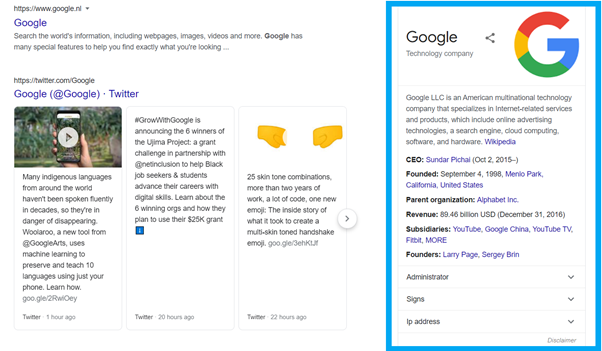Microdata
Contents
Microdata – definition and explanation
Microdata is an HTML specification used to add embedded information to elements on a page. It provides search engine crawlers and other web crawlers with further details on the page or site. This data can be used by a search engine to create a more dynamic browsing experience and understand what information is provided on the page.
There are various microdata vocabularies available, the most used one being schema.org. Most major search engines support Schema.org, often resulting in more favorable search result pages.

An image of the different Types and DataTypes on Schema.org
What is microdata used for?
Microdata is mainly used to improve the readability of a page by machines. It makes it possible to add semantics to the HTML of a page, providing search engine crawlers with more information about the page and the different elements on it.
Microdata uses HTML tags to label information as structured data. For example, it can be used to provide search engines with information on the ingredients used in a recipe, user reviews, and/or the author of a specific blog post.
Search engines can use this extra information to create a better understanding of the information on a page. They can also use it to help improve their users’ search experience, by providing them with more information directly in the SERPs.
Example
Below is a short example of microdata that can be added to articles on a website.
<span itemscope itemtype="http://schema.org/Article"><h1 itemprop="name">The importance of Microdata</h1> <p itemprop="articleBody">This page is about how microdata can be used to improve the web. Companies like Google and Bing use microdata to improve their understanding of information on a page. It is an important part of search as it makes dynamic search features possible, like knowledge panels and rich snippets. You can find more information on https://www.example.com.</p> <p>This page was written by <span itemprop="author" itemscope itemtype="http://schema.org/Person"> <span itemprop="name">John Doe</span> </span>on <span itemprop="datePublished" content="2020-10-05">10/05/2020</span>, for <span itemprop="publisher" itemscope itemtype="http://schema.org/Organization"> <span itemprop="name">ExampleCompany</span></span>.”</p></span>
How microdata can impact search results
Search engines use microdata to provide their users with more information about a page before they click through. This helps them choose the page that’s most relevant to them.
This extra information can help a website’s pages stand out in the search results, providing them with added benefits. More unique SERP listings can improve a page’s click through rate (CTR) and improve other user signals by ensuring the right people visit the right pages. SERP listings with extra elements are also called rich snippets or rich results.
There are many extra search features that major search engines like Google create using microdata. Below is an overview of some of the most common ones:
- Author
- Reviews
- Recipe information (ingredients, duration, calories, etc)
- Product price (often on Google Shopping results)
- Q&A section (Listed in Google SERPs under “People also ask” as well as in the form of featured snippet)
Google’s structured data markup tool
Although JSON-LD is recommended over microdata, Google’s structured data markup helper supports both structured data formats.
This tool makes the implementation of structured data easier for web developers and SEO professionals. Google also offers various testing tools for testing structured data, including the Rich Results Test and the Structured Data Testing Tool.
Microdata and the Google Knowledge Graph
Microdata and other forms of structured data play an essential role in the Google Knowledge Graph. To add to the knowledge graph, Google uses structured data to help improve their search engine’s understanding of different terms and concepts.
Since structured data helps Google understand a brand, the authors on a site, and other important things/concepts, microdata can appear in the knowledge panel. This panel is shown at the right side of the SERP and can increase a site’s exposure for certain brand-related keywords.

An image of the Google knowledge panel
Its importance for SEO and digital marketing
Microdata can help web developers and SEOs improve their visibility in the SERPs. The rich snippets that a page can rank for when using microdata can help improve the CTR as well as important on-page user signals. Since it ensures that only the most interested users navigate to the page, it can also reduce the server load to some extent, potentially having a positive effect on a page’s speed.
Microdata can also support search engines in understanding a page’s content. This helps them show the page on relevant SERPs and prevents the page from being listed in non-relevant SERPs.
Related links
- https://html.spec.whatwg.org/multipage/microdata.html
- https://developers.google.com/search/docs/guides/intro-structured-data
- https://schema.org/
Similar articles
| About the author |
 |